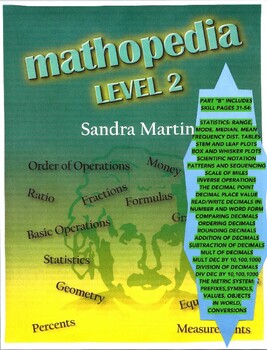Mathopedia, Level 2, PART B, Skill Pages 31-54
- PDF
Description
Math made easy: Part B of Mathopedia, Level 2 contains the following skill pages:
Statistics-Mode-Frequency Distribution Tables, Statistics-Range-Median-Mean, Stem and Leaf Plots, Box and Whisker Plots, Scientific Notation, Patterns and Sequencing, Scale of Miles, Inverse Operations, The Decimal Point, Decimal Place Value, Reading and Writing Decimals in Number Form, Reading and Writing Decimals in Word Form, Comparing Decimals, Ordering Decimals, Rounding Decimals, Addition of Decimals, Subtraction of Decimals, Multiplication of Decimals, Multiplication of Decimals by 10-100-1000, Division of Decimals, Division of Decimals by 10-100-1000, The Metric System–Prefixes-Symbols-Values, The Metric System-Objects in the World, The Metric System-Conversions
Mathopedia, Levels 1 and 2 contain 118 pages of math skills, sequentially organized from addition to pre-algebra.
1. Use Mathopedia like an encyclopedia to look up math skills that coincide with your math program. Use the one-page tricks and tips to teach or review the math skill in a memorable way.
2. Purchase one or both of the Mathopedia, Levels 1 and 2 books for more individualization. The books complement each other page by page. Level 1 boasts fewer words and easier problems for introducing lesson basics or for those that struggle. Level 2 has extra vocabulary and uses more difficult problems but mirrors Level 1 in instruction.
3. The one-page tricks and tips help all ability levels. Some students will learn the trick and be ready to move to the next skill. Others may need to refer back to the Mathopedia skill pages at varying rates or even for tests. It is easy to individualize when using both levels.
4. Another instructional option is to re-sequence your math program’s presentation of math skills with the order used in Mathopedia. The sequence of the book promotes optimum learning since success on each ordered skill page is more likely to follow with success on the following higher-level skill pages. Mathopedia uses a part-to-whole method of teaching and is easily used in coordination with any math program.
5. Teachers can use Mathopedia, Level 1 to introduce a skill to a class
and Mathopedia, Level 2 to wrap up or review the same skill for a test. Students that struggle with math may want to use Mathopedia skill pages during a test as a prompt.





